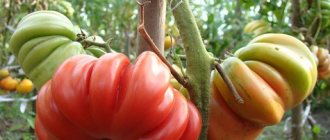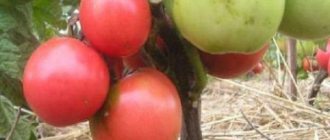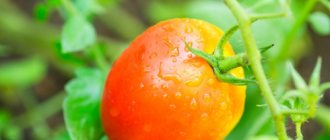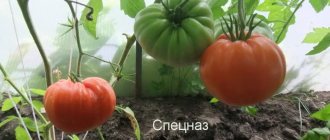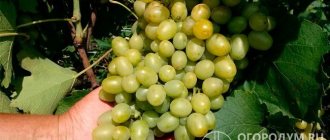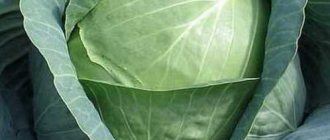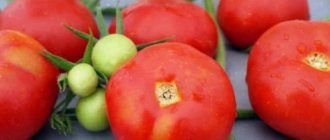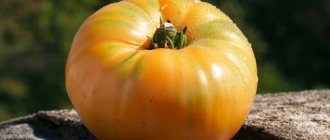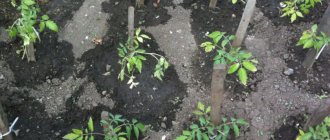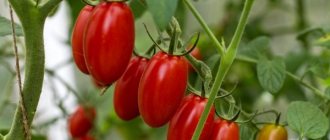Tomato Snowfall F1 is a late-ripening hybrid of the first generation with medium-sized fruits. Relatively unpretentious to grow, this hybrid has fruits with a moderately sweet taste and rich aroma. The variety has high disease resistance. Next, a description of the Snowfall tomato variety will be considered, a photo of the plant will be provided, and reviews of gardeners involved in its cultivation will be presented.
Description of the tomato variety Snowfall F1
Indeterminate, or tall, tomatoes of the Snowfall variety, according to their characteristics and description, belong to hybrids with an average ripening period. In the 3rd month of growth, the tomato bush forms the ovaries of future fruits and after another 2 - 3 weeks the first harvest can be harvested. Indeterminate varieties generously produce tomatoes throughout the entire vegetative growth of the bush.
In the State Register of Breeding Achievements of the Russian Federation, the hybrid vegetable has occupied its place of honor for more than 7 years. The Snowfall F1 variety is adapted for cultivation in open ground and grows well in greenhouse conditions. Biologists and agronomists recommend it for cultivation on farms, greenhouse complexes, garden plots and vegetable gardens.
Growing indoors is impossible due to its rapid growth. Tomato bushes can reach a height of more than two meters. The limited space will not be enough for a powerful root system, and the plant will die over time.
The tomato bush develops a strong, thick trunk with 9 fertile branches. Over time, the leaves acquire a rich green color and become large, carved and spreading. After 3 leaves, flower shoots with buds are formed. The Snowfall F1 tomato blooms with beautiful large flowers. Each flower shoot contains up to 8 tomatoes.
Ripe fruits are uniformly colored in a rich scarlet color. The vegetables are round with slight ribbing near the stalk.
Greenhouse neighbors
Snowfall is a mid-season variety, so plants with a different growing season can be planted in the same shelter with it. Ultra-early hybrids are suitable: tomato Pink Lady F1, Ivanhoe, Indigo. They begin to bear fruit earlier than Snowfall, and the tomatoes have a rich, pleasant taste. It is better to purchase plant seeds from trusted sellers; the Sedek company, which specializes in new products, has proven itself to be excellent. The company annually offers interesting hybrids with fruits of different sizes, colors and shapes. Lovers of gourmet vegetables will enjoy late-ripening classic varieties such as Black Baron, Chernomor, De Barao, and Bull's Heart. These tomato varieties ripen towards the end of summer and are a great complement to early hybrids.
The Irishka tomato, bred by Russian breeders, deserves special attention. This particularly early hybrid begins to bear fruit 90-95 days after germination, the tomatoes ripen with beautiful long trusses. Another promising neighbor is the Lyubov tomato, which belongs to a large and popular group of mid-early hybrids. The plant is determinate, miniature bushes tolerate lack of light well and will feel quite comfortable in the same greenhouse with tall Snowfall.
Taste qualities of fruits
According to the description of appearance and taste, tomatoes of the Snowfall F1 variety are practically no different from their counterparts:
- the fruits are round in shape and uniformly red in color;
- medium size and weighing just over 100 g;
- with slight ribbing near the stalk;
- dense juicy pulp, sourish in taste.
The taste of Snowfall is not inferior to other hybrid varieties: the fruit pulp is juicy with a pleasant aftertaste.
Snowfall F1 tomatoes tolerate transportation well and do not crack. Thanks to their dense peel, they can be stored for a long time and ripen at room temperature in a dry place. The fruits are good to eat fresh and in salads. When canned, the fruits retain their density and do not crack.
Diseases and pests: prevention and control methods
Like other hybrids, the Snowfall tomato is resistant to major nightshade diseases. Read about varieties with this same trait here. And in this article you will find information about tomatoes that do not suffer from late blight.
Snowfall is almost not affected by mosaics, fusarium, and verticillium . Heavy spraying with copper-containing preparations will protect tomatoes from late blight epidemics. Affected parts of plants are promptly destroyed.
Industrial insecticides or decoctions of celandine and onion peels will help get rid of pests. They are effective against flying insects, aphids, and Colorado potato beetle larvae.
On our website you can get acquainted with the varieties of tomatoes that are most resistant to various nightshade diseases. You will also learn how indeterminate varieties differ from determinate varieties.
Snowfall is a promising, unpretentious and productive hybrid. By planting several bushes in your garden, you can collect fruits from mid-summer until the end of the season.
We also bring to your attention useful materials on how to grow a good crop of tomatoes in open ground, how to do it in a greenhouse, all year round. And also what subtleties of growing early varieties should be known to every gardener.
Pros and cons of the Snowfall tomato variety
Tomato seeds Snowfall F1 were developed by domestic breeders for Russian climatic conditions.
Tomatoes of this variety have many advantages:
- Frost resistance. The seeds germinate well in the cold soil of open ground. The tomato bush can withstand low temperatures and the first frosts. This feature of the Snowfall F1 hybrid is suitable for growing tomatoes in difficult climatic conditions.
- High rates of seed germination and yield.
- Fruiting throughout the entire growing season of the plant.
- Good taste of tomatoes.
- Resistance of tomatoes to cracking during transportation.
- The hybrid grows equally well in open and closed ground.
You should take into account the indeterminate nature of the variety and be prepared for the rapid growth of the tomato bush. Timely formation of 1 or 2 trunks will ensure a neat appearance of the plant.
Growing the Snowfall F1 tomato in an apartment is impossible due to its enormous size of the tops and powerful root system. Miniature or dwarf varieties of tomatoes and cherry tomatoes are suitable for a window sill or loggia.
Optimal growing conditions
Tomatoes Snowfall F1 are grown from seeds or in seedlings from already grown seedlings.
For successful germination, seeds need:
- loose soil for air exchange;
- maintaining the temperature above 22 °C;
- regular soil moisture.
For seedlings to appear, seeds are planted in the ground and sprinkled with soil. Planted seeds must be shed with water and covered with protective material for better germination. In such a greenhouse, after 5 - 8 days the first shoots appear.
Agricultural technology tomato Snowfall F1
The time for planting seeds depends on the climatic characteristics of the region. The best time to start germinating tomatoes is the spring months from March to April.
For disinfection, seeds are treated with a solution of potassium permanganate or hydrogen peroxide. Experienced gardeners recommend soaking the seeds in a growth stimulant to speed up the appearance of sprouts.
To plant seeds, you must first prepare:
- purchase seedling containers;
- Buy ready-made soil in a specialized store or make it yourself from humus and soil in equal parts (add a little extra sand to make the soil structure airy and loose).
Growing seedlings
Growing tomato seedlings Snowfall F1 begins with sowing seeds. A layer of gravel is poured into the bottom of the container and soil is poured on top. Make furrows 1-2 cm deep and sow 1-2 seeds. The seeds are watered with warm water and covered with polyethylene to create a greenhouse effect. In a humid and warm environment, seedlings appear faster.
After a week, sprouts appear with a light green tender stem and the first two leaves.
With the appearance of the 2nd - 3rd leaf, you can transplant the young plants into separate pots.
When transplanting plants from a common container, it is important to monitor the soil and sunlight. Young seedlings are capable of stretching out behind a portion of rays, so periodically it is necessary to turn the pots of tomatoes so that the trunk of the plant is straight and does not bend in one direction or the other.
Landing rules
Before planting, young seedlings begin to harden off. This process takes up to 2 weeks. First, the pots with the plant are placed on the balcony or street for a few minutes, then the time is increased to several hours. Every day the plants stay outside should increase. This is necessary for adaptation and rapid rooting of tomato bushes in the ground.
For the correct formation of the root system and uniform distribution of sunlight, plants need to be planted at a density of more than 3 - 4 bushes per 1 square meter. m. It is necessary to install supports next to the bush, because in a couple of weeks rapid growth will begin: you will have to tie up the trunk and branches.
Watering and fertilizing
The tomato belongs to the nightshade family, which requires sufficient water for normal development. An important feature: young plants need water and fertilizing in larger quantities than adults. As they grow, tomato bushes are watered less and less, reducing watering to once a week. Excessive moisture can lead to cracking of the fruit or rotting of the entire bush.
The Snowfall F1 tomato is unique in that it tolerates long periods of time without watering.
As a top dressing, tomatoes accept complex mineral supplements well. Organic mulch in the form of hay, sawdust or straw can become a source of additional plant nutrition.
Pinching and tying
The correct tomato bush is:
- root system;
- main stem;
- branches with leaves.
Shoots form on the main stem, which can take away nutritional properties and strength. In order for the plant to direct all its strength into one trunk, young shoots must be pinched in a timely manner.
If a tomato bush consists of 2 or more stems, then the harvest becomes small or absent altogether.
Formation
A large indeterminate bush of the Snowfall F1 variety requires formation and timely tying up.
The stem holds branches with powerful leaves and clusters of tomatoes. It needs help, so tying it up will protect the plant from fractures.
This is especially true during the first snow. The tied branches will withstand even such a load.
Protection from diseases and pests
The most common problem that all summer residents encounter is late blight. Hybrid Snowfall F1 is resistant to this disease and to all other diseases typical of nightshades.
For Snowfall tomatoes, it is enough to carry out preventive work:
- remove wilted leaves and weeds;
- strengthen plants by fertilizing with mineral fertilizers;
- use folk methods in the form of spraying from decoctions of onion peels or bread tincture.
Features of care
When growing tomatoes, they are watered 2-3 times a week and fed periodically. The first fertilizing is carried out with nitrogen compounds (ammonium nitrate or urea), at the rate of 25 grams per 1 m2. The second is phosphorus-potassium, it is performed a month after the first. Another month later - the third, also phosphorus-potassium. You should not overdo it with nitrogen fertilizers, as they lead to an increase in green mass and a decrease in yield.
Foliar feeding is also useful. Snowfall is sprayed with a superphosphate solution 1-2 times during the summer.
It is also worth keeping in mind that too much watering harms plants. The soil should be moistened moderately, increasing the amount of moisture only during dry periods. Water at the root; sprinkling is not recommended. After this, the greenhouse is opened for ventilation. This helps prevent the appearance of blackleg and gray rot.
If aphids are noticed on the bushes, they are washed with soapy water. A solution of ammonia helps against slugs. To do this, 1 liter of ammonia with a concentration of 10% is diluted in 5 liters of water. If there is no ammonia in such quantities, you can take less. The prepared solution is sprayed on the plants.
